The NVIDIA GeForce GTX 980 Ti Review
by Ryan Smith on May 31, 2015 6:00 PM ESTPower, Temperature, & Noise
As always, last but not least is our look at power, temperature, and noise. Next to price and performance of course, these are some of the most important aspects of a GPU, due in large part to the impact of noise. All things considered, a loud card is undesirable unless there’s a sufficiently good reason – or sufficiently good performance – to ignore the noise.
As the GM200 flagship card, GTX Titan X gets the pick of the litter as far as GM200 GPUs go. GTX Titan X needed fully-functional GM200 GPUs, and even then needed GPUs that were good enough to meet NVIDIA’s power requirements. GTX 980 Ti on the other hand, as a cut-down/salvage card, gets second pick. So we expect to see these chips be just a bit worse; to have either functional units that came out of the fab damaged, or have functional units that have been turned off due to power reasons.
| GeForce GTX Titan X/980 Voltages | ||||
| GTX Titan X Boost Voltage | GTX 980 Ti Boost Voltage | GTX 980 Boost Voltage | ||
| 1.162v | 1.187v | 1.225v | ||
Looking at voltages, we can see just that in our samples. GTX 980 Ti has a slightly higher boost voltage – 1.187v – than our GTX Titan X. NVIDIA sometimes bins their second-tier cards for lower voltage, but this isn’t something we’re seeing here. Nor is there necessarily a need to bin in such a manner since the 250W TDP is unchanged from GTX Titan X.
| GeForce GTX 980 Ti Average Clockspeeds | |||
| Game | GTX 980 Ti | GTX Titan X | |
| Max Boost Clock | 1202MHz | 1215MHz | |
| Battlefield 4 |
1139MHz
|
1088MHz
|
|
| Crysis 3 |
1177MHz
|
1113MHz
|
|
| Mordor |
1151MHz
|
1126MHz
|
|
| Civilization: BE |
1101MHz
|
1088MHz
|
|
| Dragon Age |
1189MHz
|
1189MHz
|
|
| Talos Principle |
1177MHz
|
1126MHz
|
|
| Far Cry 4 |
1139MHz
|
1101MHz
|
|
| Total War: Attila |
1139MHz
|
1088MHz
|
|
| GRID Autosport |
1164MHz
|
1151MHz
|
|
| Grand Theft Auto V |
1189MHz
|
1189MHz
|
|
The far more interesting story here is GTX 980 Ti’s clockspeeds. As we have pointed out time and time again, GTX 980 Ti’s gaming performance trails GTX Titan X by just a few percent, this despite the fact that GTX 980 Ti is down by 2 SMMs and is clocked identically. On paper there is a 9% performance difference that in the real world we’re not seeing. So what’s going on?
The answer to that is that what GTX 980 Ti lacks in SMMs it’s making up in clockspeeds. The card’s average clockspeeds are frequently two or more bins ahead of GTX Titan X, topping out at a 64MHz advantage under Crysis 3. All of this comes despite the fact that GTX 980 Ti has a lower maximum boost clock than GTX Titan X, topping out one bin lower at 1202MHz to GTX Titan X’s 1215MHz.
Ultimately the higher clockspeeds are a result of the increased power and thermal headroom the GTX 980 Ti picks up from halving the number of VRAM chips along with disabling two SMMs. With those components no longer consuming power or generating heat, and yet the TDP staying at 250W, GTX 980 Ti can spend its power savings to boost just a bit higher. This in turn compresses the performance gap between the two cards (despite what the specs say), which coupled with the fact that performance doesn't scale lineraly with SMM count or clockspeed (you rarely lose the full theoretical performance amount when shedding frequency or functional units) leads to the GTX 980 Ti trailing the GTX Titan X by an average of just 3%.
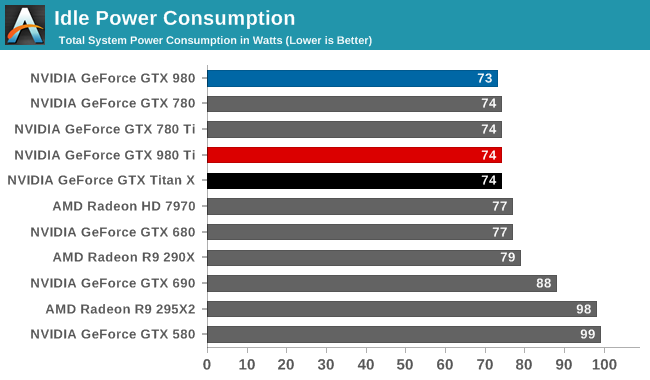
Starting off with idle power consumption, there's nothing new to report here. GTX 980 Ti performs just like the GTX Titan X, which at 74W is second only to the GTX 980 by a single watt.
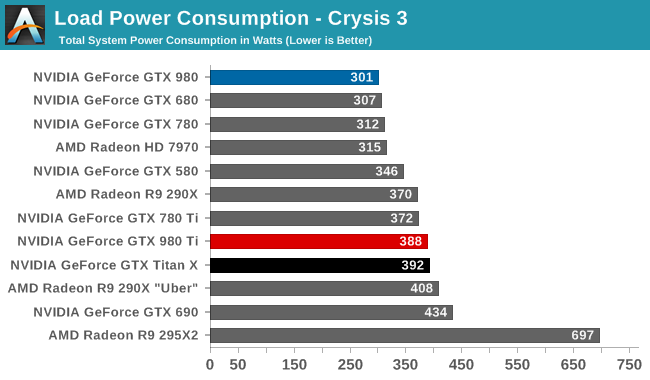
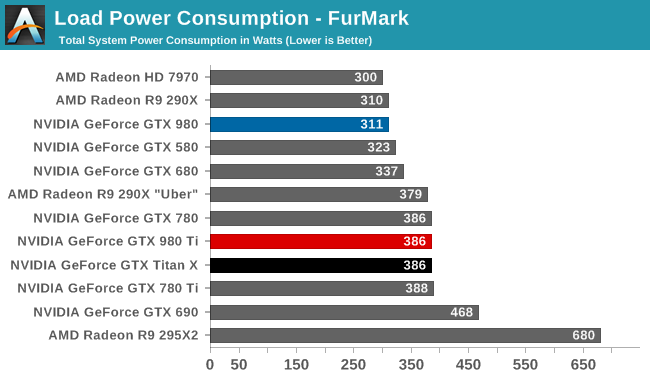
Meanwhile load power consumption is also practically identical to the GTX Titan X. With the same GPU on the same board operating at the same TDP, GTX 980 Ti ends up right where we expect it, next to GTX Titan X. GTX Titan X did very well as far as energy efficiency is concerned – setting a new bar for 250W cards – and GTX 980 Ti in turn does just as well.
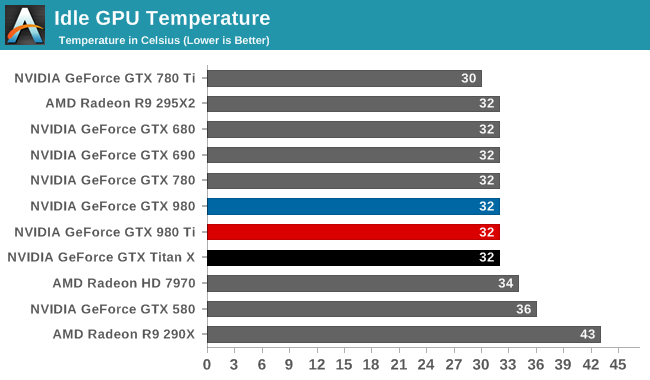
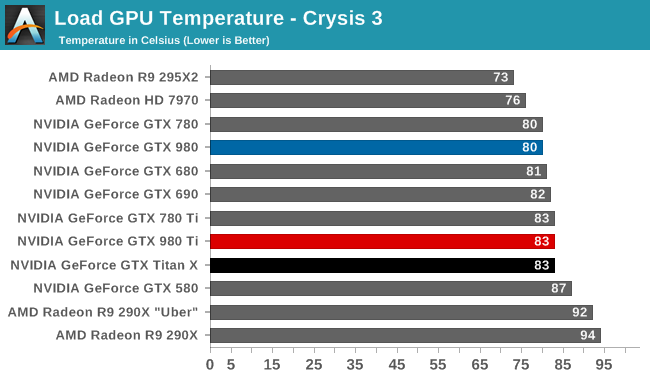
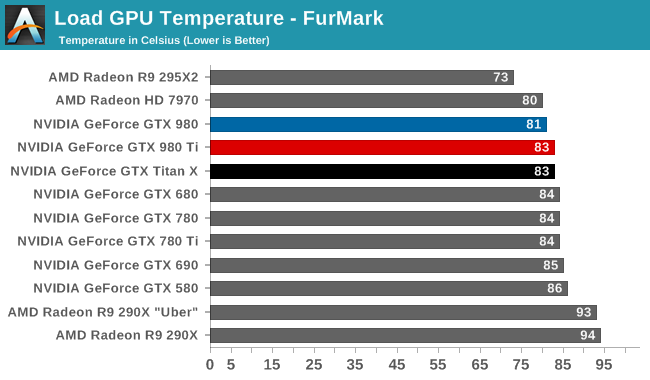
As was the case with power consumption, video card temperatures are similarly unchanged. NVIDIA’s metal cooler does a great job here, keeping temperatures low at idle while NVIDIA’s GPU Boost mechanism keeps temperatures from exceeding 83C under full load.
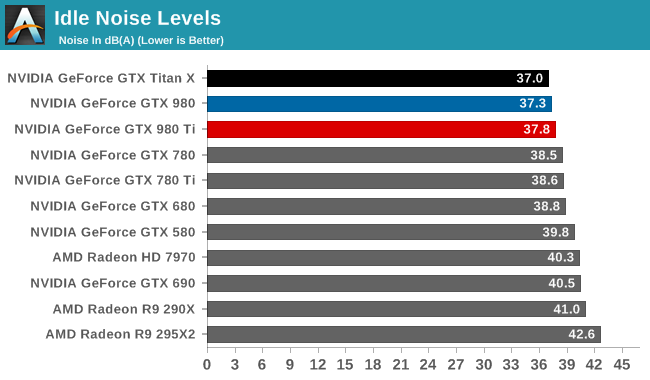
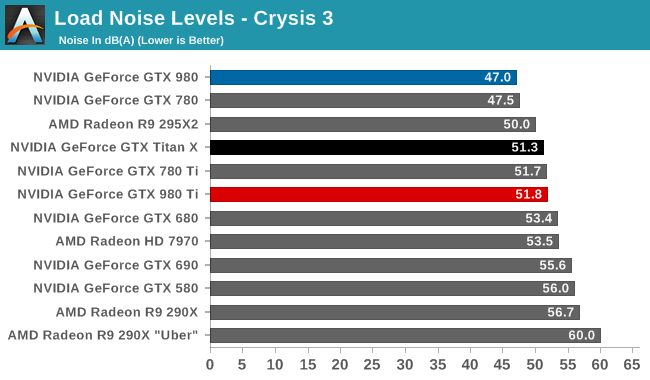
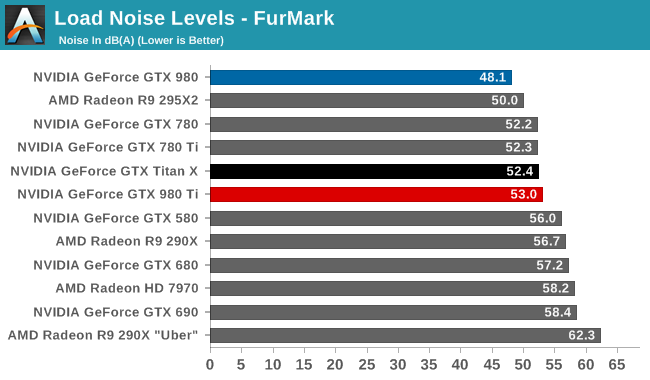
Finally for noise, the situation is much the same. Unexpected but not all that surprising, the GTX 980 Ti ends up doing a hair worse than the GTX Titan X here. NVIDIA has not changed the fan curves or TDP, so this ultimately comes down to manufacturing variability in NVIDIA’s metal cooler, with our GTX 980 Ti faring ever so slightly worse than the Titan. Which is to say that it's still right at the sweet spot for noise versus power consumption, dissipating 250W at no more than 53dB, and once again proving the mettle of NVIDIA's metal cooler.










290 Comments
View All Comments
Yojimbo - Monday, June 1, 2015 - link
After some research, I posted a long and detailed reply to such a statement before, I believe it was in these forums. Basically, the offending NVIDIA rebrands fell into three categories: One category was that NVIDIA introduced a new architecture and DIDN'T change the name from the previous one, then later, 6 months if I remember, when issuing more cards on the new architecture, decided to change to a new brand (a higher numbered series). That happened once, that I found. The second category is where NVIDIA let a previously released GPU cascade down to a lower segment of a newly updated lineup. So the high end of one generation becomes the middle of the next generation, and in the process gets a new name to be uniform with the entire lineup. The third category is where NVIDIA is targeting low-end OEM segments where they are probably fulfilling specific requests from the OEMs. This is probably the GF108 which you say has "plagued the low end for too long now", as if you are the arbiter of OEM's product offerings and what sort of GPU their customers need or want. I'm sorry I don't want to go looking for specific citations of all the various rebrands, because I did it before in a previous message in another thread.The rumors of the upcoming retail 300 series rebrand (and the already released OEM 300 series rebrand) is a completely different beast. It is an across-the-board rebrand where the newly-named cards seem to take up the exact same segment as the "old" cards they replace. Of course in the competitive landscape, that place has naturally shifted downward over the last two years, as NVIDIA has introduced a new line up of cards. But all AMD seems to be doing is introducing 1 or 2 new cards in the ultra-enthusiast segment, still based on their ~2 year old architecture, and renaming the entire line up. If they had done that 6 months after the lineup was originally released, it would look like indecision. But being that it's being done almost 2 years since the original cards came out, it looks like a desperate attempt at staying relevant.
Oxford Guy - Monday, June 1, 2015 - link
Nice spin. The bottom line is that both companies are guilty of deceptive naming practices, and that includes OEM nonsense.Yojimbo - Monday, June 1, 2015 - link
In for a penny, in for a pound, eh? I too could say "nice spin" in turn. But I prefer to weigh facts.Oxford Guy - Monday, June 1, 2015 - link
"I too could say 'nice spin' in turn. But I prefer to weigh facts."Like the fact that both companies are guilty of deceptive naming practices or the fact that your post was a lot of spin?
FlushedBubblyJock - Wednesday, June 10, 2015 - link
AMD is guilty of going on a massive PR offensive, bending the weak minds of it's fanboys and swearing they would never rebrand as it is an unethical business practice.Then they launched their now completely laughable Gamer's Manifesto, which is one big fat lie.
They broke ever rule they ever laid out for their corpo pig PR halo, and as we can see, their fanboys to this very day cannot face reality.
AMD is dirtier than black box radiation
chizow - Monday, June 1, 2015 - link
Nice spin, no one is saying either company has clean hands here, but the level to which AMD has rebranded GCN is certainly, unprecedented.Oxford Guy - Monday, June 1, 2015 - link
Hear that sound? It's Orwell applauding.Klimax - Tuesday, June 2, 2015 - link
I see only rhetoric. But facts and counter points are missing. Fail...Yojimbo - Tuesday, June 2, 2015 - link
Because I already posted them in another thread and I believe they were in reply to the same guy.Yojimbo - Tuesday, June 2, 2015 - link
Orwell said that severity doesn't matter, everything is binary?